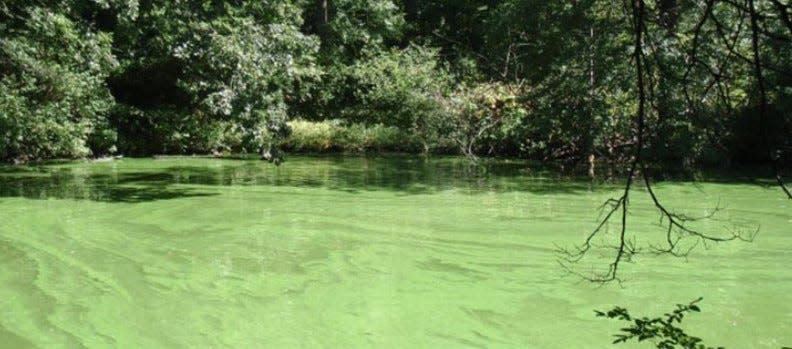Toxic blue-green algae bloom warnings issued in RI. Where they are and what to know
Rhode Island is reporting its second blue-green algae bloom, also known as cyanobacteria, of the season.
The Rhode Island Department of Health (RIDOH) and the Rhode Island Department of Environmental Management (RIDEM) are advising people to stay out of Tiogue Lake in Coventry, a popular fishing and swimming spot, after routine testing found high concentrations of cyanobacteria toxins in the water. On June 5, an advisory was issued for Almy Pond in Newport.
The algae blooms release toxins that are harmful to humans and animals, particularly children. The agencies say that it's possible blooms are starting in other water bodies in the state.
Here's what to know and what to look for.
What is a blue-green algae bloom?

Blue-green algae is naturally found in many freshwater ecosystems and is actually a bacteria, not a true algae. This cyanobacteria thrives in warm, nutrient-rich waters.
"A combination of excess nutrients (particularly phosphorus), sunlight, and high temperatures can lead to a rapid increase in blue-green algae, which is called a 'bloom,'" said Jane Sawyers, the DEM supervising environmental scientist program supervisor, in an email.
These blooms can have toxins in them, toxins that can only be determined through laboratory testing.
Rather than take the risk, DEM recommends on its website that people stay out of any water that looks like it could be having a blue-green algae bloom. Look for water that looks like pea soup, green cottage cheese or like green paint has been spilled across the top of it. The blooms can also produce a swampy odor.
"People are advised to avoid contact with waterbodies that exhibit bright green coloration in the water or at the water surface and/or dense floating algal mats that form on the water's surface," the press release said.
The toxins can linger in the water even after the bloom is no longer visible, according to the press release.
Is it safe to swim in blue-green algae? Kayak? Fish? Can my dog swim in it?
No, no, no and no, according to the Rhode Island Department of Health.
RIDOH recommends people avoid fishing, boating, kayaking and definitely swimming in bodies of water where a blue-green algae advisory is in effect.
The water is also harmful to animals, so you shouldn't allow your dog (or other pets) to drink or swim in the water.
What are the symptoms of blue-green algae exposure? What should you do if exposed?
If your skin comes in contact with cyanobacteria, RIDOH says you might experience skin, nose, eyes and/or throat irritation.
If you ingest water with algal toxins you might experience:
Stomach ache
Diarrhea
Vomiting
Nausea
Dizziness
Headache
Fever
Liver damage
Nervous system damage
The last five points on the list are rarer. However, "young children and pets are at a particular risk for health effects associated with algal toxins," according to the press release.
People who experience these symptoms should talk to their doctor.
If you come into contact with water you are suspicious of, rinse your skin with clean water as soon as possible, and when you get home take a shower and wash your clothes.
If your pet comes in contact with the water, wash them with clean water as soon as possible and do not let them lick their fur.
If within a day of being in contact with the water, your pet show loss of energy, loss of appetite, vomiting, diarrhea, or any unexplained sickness, contact your veterinarian.
How common are blue-green algae blooms?
With cyanobacteria naturally occurring in many freshwater ecosystems, they're fairly common. DEM monitors 17 lakes, ponds and reservoirs on a bi-weekly basis, and last year ended up checking 22 bodies of water.
In 2022, 19 blue-green algae advisories were issued in Rhode Island. The same number was issued in 2021, and there were 17 in 2020, 14 in 2019, and 16 in 2018, according to RIDEM stats. During the last four years, the first advisory was issued in mid-June, and there are usually blooms reported through the end of the year.
As the days get longer and warmer, the blooms become more likely, Sawyers said, noting the blooms usually peak in late summer and early fall.
"It’s very weather and waterbody dependent," Sawyers wrote. "As the climate is warming and weather patterns changing, research indicates that Rhode Island, along with other states and countries, will likely see more blooms, given that blue-green algae bloom compete well in warmer, nutrient-laden waters."
How long does a blue-green algae bloom last?
There is no way to estimate the length of a bloom, according to Sawyers.
"Blue-green algae blooms can be temporary (lasting a few days) to several months," she wrote.
Poisonous plants in RI: How to ID and symptoms to watch for
For reference, last year an advisory for Tiogue Lake was issued on June 27 and lifted on July 15. The Almy Pond bloom last year lasted from June 10 to December 15.
How do I report a bloom?
Send reports of suspected blue-green algae blooms, along with photographs, if possible to DEM.OWRCyano@dem.ri.gov.
Battle of the bugs: RI deploys predator beetles to protect hemlock trees from invasive insect
For more information and a list of current and historical advisories, go to www.dem.ri.gov/bluegreen.
This article originally appeared on The Providence Journal: Toxic blue-green algae blooms in RI. Are they dangerous?

